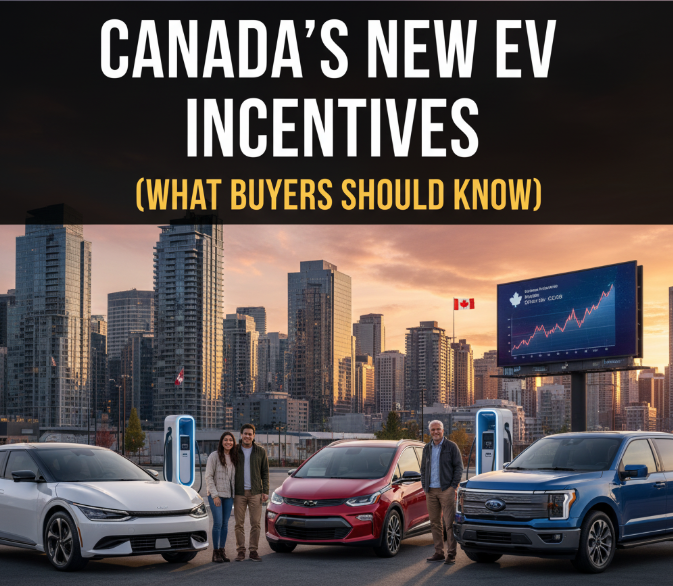Introduction
Electric vehicles (EVs) are no longer a futuristic dream—they’re here, and they’re quickly becoming part of everyday life in Canada. Rising gas prices, growing concerns about climate change, and better technology are pushing more Canadians to switch from gasoline-powered cars to EVs. But there’s another big reason EV adoption is on the rise: government incentives.
In 2025, Canada has updated and expanded its EV incentive programs to make electric vehicles more affordable and accessible for buyers across the country. These incentives come in the form of rebates, tax credits, and provincial benefits that reduce the upfront cost of owning an EV.
This article explores Canada’s new EV incentives in detail, how they work, who qualifies, and what buyers need to know before making the switch. Whether you’re considering a Tesla, a Hyundai Ioniq 6, a Ford F-150 Lightning, or a budget-friendly Nissan Leaf, this guide will help you understand how to maximize savings.
Why Canada is Pushing EV Incentives
Climate Goals and Net-Zero Targets
Canada has committed to achieving net-zero emissions by 2050, with transportation being one of the largest contributors to greenhouse gases. Since road transport accounts for nearly 25% of Canada’s total emissions, encouraging EV adoption is a critical step.
Rising Gasoline Costs
With fuel prices fluctuating, EVs present an attractive alternative. While EVs may still be more expensive upfront, incentives make them competitive with traditional vehicles.
Boosting Domestic EV Industry
In addition to helping buyers, incentives also support Canada’s growing EV manufacturing sector. The country is investing heavily in battery production, raw material mining (like lithium and cobalt), and EV assembly plants.
The Federal iZEV Program (2025 Update)
The main EV incentive in Canada is the iZEV Program (Incentives for Zero-Emission Vehicles), run by Transport Canada.
How Much Can You Save?
The amount of money you can get depends on the type of EV you buy:
| Vehicle Type | Incentive Amount | Price Cap (MSRP) |
|---|---|---|
| Battery Electric Vehicle (BEV) | Up to $5,000 | Under $55,000 (cars), up to $70,000 (SUVs/pickups) |
| Plug-in Hybrid Electric Vehicle (PHEV) | Up to $2,500 | Same as BEV price caps |
| Hydrogen Fuel Cell Vehicle | Up to $5,000 | Under $70,000 |
✅ Pro Tip: The rebate is applied directly at the dealership, meaning you don’t need to file paperwork or wait for a tax refund.
Eligible Vehicles
Not every EV qualifies. Canada has a list of eligible vehicles that includes popular models such as:
- Tesla Model 3 (base versions)
- Hyundai Ioniq 6
- Chevrolet Bolt EUV
- Nissan Leaf
- Kia EV6 (lower trims)
- Ford F-150 Lightning (entry models)
Luxury models like the Tesla Model S or Porsche Taycan do not qualify because they exceed the price cap.
Provincial EV Incentives in 2025
On top of the federal iZEV rebate, some provinces offer additional incentives. When combined, these savings can be huge.
British Columbia
- Up to $4,000 for BEVs and PHEVs.
- Extra $500–$2,000 for lower-income households.
- BC also has rebates for home charging stations (up to $350).
Quebec
- One of the most generous provinces.
- Up to $7,000 rebate for new EVs.
- Up to $600 for charging equipment.
- Combined with federal, buyers in Quebec can save up to $12,000 on a new EV.
Ontario
- Ontario currently has no direct rebate for EVs, but buyers benefit from reduced registration fees and federal incentives.
- However, there are programs for charging stations and fleet electrification.
Other Provinces
- Manitoba, Alberta, Saskatchewan – No EV purchase rebates.
- Nova Scotia & Prince Edward Island – Rebates ranging from $2,000 to $5,000.
- Newfoundland & Labrador – Up to $2,500.
| Province | Max Rebate | Charging Support | Notes |
|---|---|---|---|
| Quebec | $7,000 | Yes ($600) | Highest in Canada |
| BC | $4,000 | Yes ($350+) | Extra support for low-income |
| Nova Scotia | $3,000 | No | Smaller but helpful |
| PEI | $5,000 | No | Supports both new and used EVs |
| Ontario | None | Yes | Only charging rebates |
Stacking Incentives: How Much Can You Really Save?
Here’s an example:
Let’s say you want to buy a Hyundai Ioniq 6 (base model) in Quebec.
- MSRP: $52,000
- Federal iZEV rebate: $5,000
- Quebec provincial rebate: $7,000
- Final Price: $40,000 (before taxes/fees)
That’s a $12,000 discount instantly applied.
Incentives for Used EVs
New EVs aren’t the only ones that benefit. Some provinces support used EV buyers too:
- British Columbia: Up to $2,000 for used EVs.
- Prince Edward Island: $2,500–$3,000.
- Quebec: No rebate on used EVs, but still strong new EV benefits.
Buying used is becoming more popular as the EV market matures, making these incentives valuable for budget-conscious drivers.
EV Incentives for Businesses and Fleets
If you own a business or operate a fleet, Canada also has programs for you:
- iMHZEV Program (Medium and Heavy-Duty Zero-Emission Vehicles)
- Incentives up to $200,000 per vehicle depending on class.
- Applies to delivery vans, buses, and trucks.
- Tax Deductions
- Businesses can claim 100% depreciation in the first year for EV purchases, reducing taxable income.
Charging Station Incentives
Switching to an EV means you’ll likely need a home or workplace charger. Canada offers programs to reduce installation costs:
- Federal ZEVIP Program (Zero Emission Vehicle Infrastructure Program)
- Covers up to 50% of costs for installing chargers in workplaces, public locations, and multi-unit residential buildings.
- Provincial Add-Ons
- Quebec: Up to $600 for home chargers.
- BC: Up to $350 for home chargers, higher for multi-unit housing.
Challenges with Incentives
While incentives are helpful, there are some issues buyers should be aware of:
- Limited Vehicle Availability – Some qualifying EVs have long wait times.
- Price Caps – Many popular higher-trim EVs are excluded.
- Program Budgets – Incentives are subject to funding limits; once money runs out, programs may pause.
- Charging Infrastructure – Rural areas still lack enough fast chargers.
Tips for Buyers to Maximize EV Incentives
- Check Eligibility Before Buying
– Confirm the model you want is on the official list. - Act Quickly
– Funding pools can run out fast. - Combine Federal and Provincial Rebates
– The biggest savings come from stacking both. - Look for Dealer Incentives
– Some automakers add their own discounts. - Consider Total Cost of Ownership
– EVs save on fuel and maintenance long-term.

EV Incentives vs. Gas Vehicle Costs
To really see the benefits, let’s compare costs over 5 years:
| Vehicle Type | Average Purchase Price | Incentives Applied | Fuel Cost (5 yrs) | Maintenance Cost (5 yrs) | Total 5-Year Cost |
|---|---|---|---|---|---|
| Gas Car | $35,000 | $0 | $10,000 | $4,000 | $49,000 |
| EV (with incentives) | $45,000 | -$7,000 to -$12,000 | $2,000 | $2,000 | $37,000–$40,000 |
Even if an EV costs more upfront, incentives and lower running costs make it cheaper in the long run.
Future of EV Incentives in Canada
The Canadian government plans to:
- Maintain iZEV rebates until at least 2026.
- Expand incentives for commercial fleets.
- Invest billions in charging infrastructure.
- Push for 100% of new car sales to be zero-emission by 2035.
Conclusion
Canada’s new EV incentives in 2025 make owning an electric vehicle more affordable than ever before. With federal rebates up to $5,000, generous provincial programs (like Quebec’s $7,000 incentive), and added support for charging stations and fleets, Canadians can save thousands of dollars when switching to an EV.
However, it’s important to understand the eligibility rules, price caps, and availability issues before making a purchase. By combining incentives wisely and factoring in long-term savings, EV buyers can make smarter financial and environmental choices.
The bottom line? If you’ve been considering an EV, 2025 is one of the best years to buy one in Canada. The savings are real, the technology is better than ever, and you’ll be driving into a greener, cleaner future.

Leave a Reply